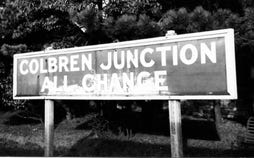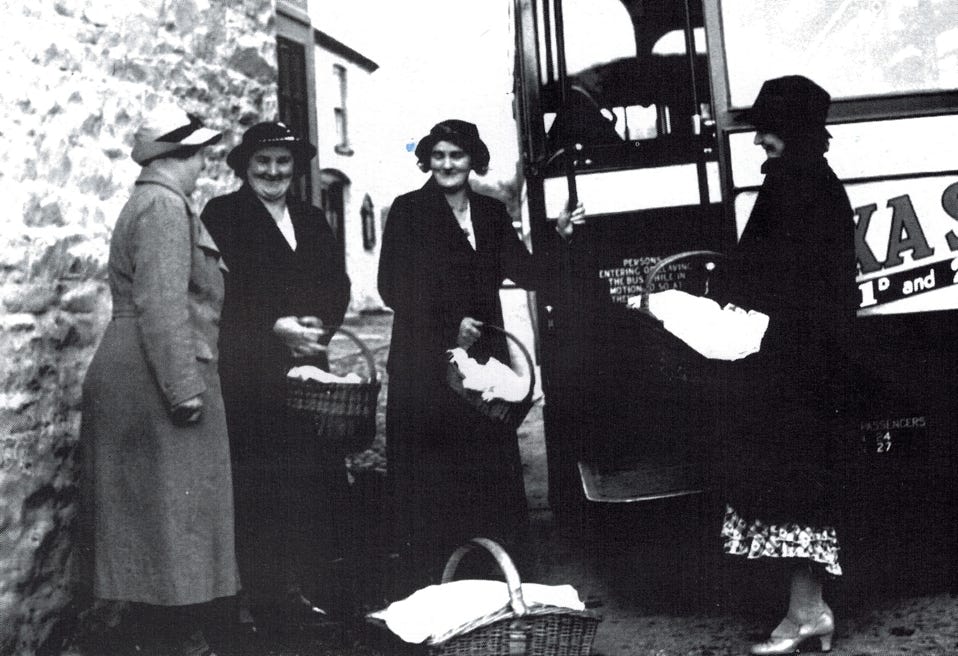“Well I tell you, when I was about 14 years old [c.1942], I’d started in this commerce class in Cadoxton School as a pupil, and I came home on a Monday afternoon - and, in those days, you had those beautiful summers - and my mother said to me, “I want you to come with me on Saturday to Llandovery, to Halfway”, she said. “I’d like to show you where the family used to worship, and perhaps we’ll meet a member of the family, who knows?” So, we set out now to catch the 8 o’clock bus from Penycae. We walked - it was safe enough in those days - it isn’t safe today for me, I’m afraid to walk that road, it’s so lonely - and we set out to catch the 8 o’clock bus. So, we got to Sennybridge and caught another bus now, the Llandovery bus, for Halfway. We got to Halfway and my mother said, now “There are some of the children out of the chapel and I don’t know whether it’s open but I just want to show you where the family used to worship.” It’s a similar chapel to Nantyffin, you walk in through the main door and the pulpit is behind you. So she said to me,“I’m not strong enough to lift you up, there are some flat stones, now, pile them up and have a look inside.” Now with that, a man came on horseback. “It’s all right,” my mother said, “we’re not doing any damage here, I just want to show my daughter where the family used to worship. “Oh,” he said, “well how far have you come?” in Welsh, of course, all in Welsh.” “Coelbren”, we said. “Oh, I had relatives in Coelbren and I don’t know if they’re still living there; where in Coelbren?” “Coelbren House,” we said. “Good heavens”, my mother said, “and who are you?” “Ivor,” he said*, and he had this dog, and he dismounted now from the horse, and he said, “Well who are you?” “Olwen”, she said. “Good heavens, we haven’t met for years.” “Are you still living in Yscoed-dreffin, Ivor?” “No, no. I now live in a farm called Crug-y-bwbach, I’d like you to come up to the farm.” “Oh, no,” my mother said, “are you married yet?” He said “Yes, and I’ve been blessed with two daughters. Unfortunately, the two daughters have left for Brecon,” he said, to me, but so he said, “Please come, Olwen.” So, anyway, he took us up to the farm and of course it was a good way from the main road, and his wife was busy making cawl and this cauldron, it was hanging on a hook and chain, in the flames of the fire, and there was a settle inside of the grate and in it this little woman, and my mother said, “Well, I’m very sorry, intruding like this.” “Any relative of Ivor is a relative of mine,” she said, “and you’re most welcome.” She made us a cup of tea and while we were having the tea, she said, “what are your interests?” “I like to sew,” my mother said. “Really,” she said, “I’ve bought lots of material on the black market but I just don’t know what to cut out, to make a garment. Can you?” Well, they hit it off, they got along really well. So before lunch, this woman took my mother into the front room and showed her the material, the patterns she had, and my mother started laying the material out, pinning the patterns on and cutting them out and folding them up...she showed her and cut enough sufficient for her to make about six garments, I think, and he said to me, “I’d like you to come into the garden with me to pick gooseberries; I want you to come with me to pick gooseberries.
The photograph from Davies (2003) is dated at 1938. The bus was bound for Brecon.
And he had a basket made from willow, a woven basket. “How many gooseberries do you want picked?” I said. “As many as we can,” he said. And of course I didn’t know what he had in mind, not then. So anyway we were called in for lunch and we had a lovely afternoon with them, and he said, “Now then, you don’t go home by bus,” he told my mother. “I’ve got a return ticket,” she said. And of course, if I wore my school things, she could have half fare for me, so I wore my school frock, blazer, so she had half-return for me. “Now then,” he said, “I’m going to give you a fare to go home by train, and I’ll take you in the trap, horse and trap, to the station.” Well, lo and behold, when we got to the station, he handed this basket over to my mother, well it had been covered of course, paper, if I remember rightly, and when we got back to Coelbren, there was a pound of farm butter in the middle of the gooseberries, so there was a method in his madness, and of course the reason why he didn’t want us to go back by bus, was that the police would be watching at Penycae for the black market stuff but mind we were jolly glad to have a train home that night, not having to walk from Penycae, because it was a typical summer’s day, a scorching day.”

